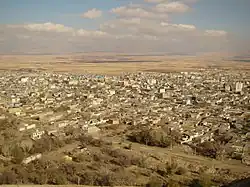Qeydar
Persian: قيدار | |
|---|---|
City | |
 Qeydar from above | |
 Qeydar | |
| Coordinates: 36°07′10″N 48°35′30″E / 36.11944°N 48.59167°E[1] | |
| Country | Iran |
| Province | Zanjan |
| County | Khodabandeh |
| District | Central |
| Population (2016)[2] | |
| • Total | 34,921 |
| Time zone | UTC+3:30 (IRST) |
Qidār (Persian: قيدار, also Romanized as Qīdar, Qidar; also known as Geydar, Ghaidar, Keydar, Kedar, Geydār Palnamnār, Ghaidar Paighambar, Keydar-Peygambar, and Qidār Peyghāmbar)[3] is a city in the Central District of Khodabandeh County, Zanjan province, Iran, and serves as capital of both the county and the district.[4]
At the 2006 census, its population was 25,525 in 6,253 households.[5] The following census in 2011 counted 30,251 people in 7,997 households.[6] The latest census in 2016 showed a population of 34,921 people in 10,028 households.[2]
Azerbaijani is the native language of the city. Qeydar is also well known for its agriculture. Khodabandeh County was the birthplace of Sheikh Shahabaddin Sohravardi.
Tourist attractions
Examples of known tourist attractions within the city include the historic Mausoleum of Prophet Qeydar and the ancient Katale Khor caves.
References
- ↑ OpenStreetMap contributors (26 February 2023). "Qeydar, Khodabandeh County" (Map). OpenStreetMap. Retrieved 26 February 2023.
- 1 2 "Census of the Islamic Republic of Iran, 1395 (2016)". AMAR (in Persian). The Statistical Center of Iran. p. 19. Archived from the original (Excel) on 27 April 2022. Retrieved 19 December 2022.
- ↑ Qeydar can be found at GEOnet Names Server, at this link, by opening the Advanced Search box, entering "-3080190" in the "Unique Feature Id" form, and clicking on "Search Database".
- ↑ Habibi, Hassan (7 July 1369). "Approval of the organization and chain of citizenship of elements and units of country divisions of Zanjan province, centered in Zanjan city". Lamtakam (in Persian). Ministry of Interior, Council of Ministers. Archived from the original on 16 December 2023. Retrieved 16 December 2023.
- ↑ "Census of the Islamic Republic of Iran, 1385 (2006)". AMAR (in Persian). The Statistical Center of Iran. p. 19. Archived from the original (Excel) on 20 September 2011. Retrieved 25 September 2022.
- ↑ "Census of the Islamic Republic of Iran, 1390 (2011)". Syracuse University (in Persian). The Statistical Center of Iran. p. 19. Archived from the original (Excel) on 21 January 2023. Retrieved 19 December 2022.
